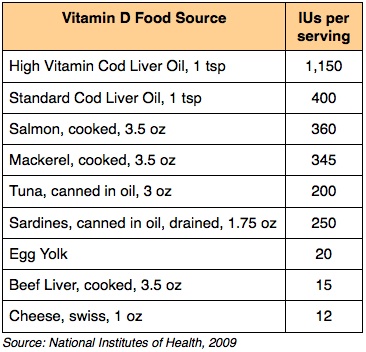Are you vitamin D deficient? This is a hot question in the health field these days, with experts estimating that between 70-90% of individuals living in the United States and Canada are deficient in vitamin D. Out of fears of "dangerous rays," we have been trained to be a sun-phobic culture slathered in pasty sunblocks and flaunting gargantuan floppy hats every time we peek our heads out the door. It seems we have paradoxically worked our way into completely blocking out our most valuable source of vitamin D: the sunshine! This realization has sent those in the health field into a tizzy, resulting in a flurry of ground-breaking research about vitamin D and a new line of synthetically made supplementation products to fix this deficiency. With studies exploring the sunshine vitamin's importance in preventing a myriad of conditions from bone fractures to cancer to depression, there is a an article released about its usefulness nearly everyday. However, despite this paradigm shift, vitamin D levels remain low in many individuals. Why? Perhaps it is time to consider the mechanism of this unusual vitamin and realize that like all nutrients, it certainly doesn't work alone.
Vitamin D: Not your average nutrient
Vitamin D is an unusual member of the vitamin family. While we generally obtain our vitamins from the foods we consume, there are no particular sources high enough in this nutrient to solely sustain our bodily requirements. Instead, vitamin D must also be synthesized under the skin in a process involving ultraviolet light exposure. Once in the body, vitamin D is converted into a hormonally active form called calcitriol, which is structurally similar to cortisone and estrogen. This compound plays an integral role in the orchestration of various physiological functions and is so important that most, if not all, cells in the human body have a receptor for it. Vitamin D is most well known for the regulation of calcium and phosphorous metabolism to maintain bone strength and development, as well as for playing an essential role in proper thyroid function, preserving a strong nervous system, regulating cardiac function and supporting the immune system.
Am I Getting Enough Natural Sources of Vitamin D?

Obviously, when working to correct a deficiency, it is important to ensure that there is an adequate amount of the nutrient present in the diet and environment. There are many ways to obtain vitamin D as described in our posts on natural sources of vitamin D as well as ways to avoid this unrecognized epidemic. As is popularly described, the very best way to get enough vitamin D is to get outside into the sunshine. When the skin is touched by ultraviolet b (UVB) rays, it has the capacity to manufacture 10,000 IUs of vitamin D in just 30 minutes. The issue here however, is that each section of skin only has a certain capacity for synthesizing vitamin D, at which point it becomes saturated and will no longer contribute to the conversion process. Therefore in order to get the full amount of the nutrient from the sun, one would have to lounge out essentially naked at noontime for about a half an hour when the UVB rays are strongest. Environmental and lifestyle restrictions in our modern world can clearly make this difficult if you do not reside in a tropical climate where bathing suits can be donned throughout the year. With the modern human spending nearly 90% of their time indoors, it is particularly important to monitor vitamin D levels in areas of high pollution and smog cover, as well as during winter months in the northern hemisphere when days are shorter and the slant of the sun’s rays at a lesser angle.
Although foods sources of vitamin D are few in number, they are important to include in the diet. Below you will find a table of key foods and their vitamin D content. The current daily value for intake as dictated by the FDA is between 400-800 IUs (International Units). However many health care providers state that an optimal intake rests somewhere between 2,000-5,000 IUs per day, with some individuals requiring "megadose supplementation" at rates that are much higher. It is important to collaborate with your natural health care practitioner to find what works best for your system. As you will notice seafoods tend to be the highest concentrated with vitamin D. This is likely due to the high amount of plankton consumed in their food chain, which is rich in easily converted vitamin D precursors.

Another way of getting vitamin D is through supplementation, however this must be approached with caution as the vitamin industry can be quite difficult to navigate. There are two major sources from which supplemental vitamin D is derived. D2 (ergocalciferol) comes primarily from irradiated yeasts and mushrooms, and is both the cheapest and easiest supplement to make. It is the substance used for vitamin D fortified foods such as commercial milks and cereals. Some studies however, have found it to be minimally helpful in increasing vitamin D levels in the body. D3 (cholecalciferol) is derived from fish and carnivorous or omnivorous mammals where it is produced in their skin and the oils of their fur. Athough more expensive to make, D3 has a higher affinity for vitamin D carrier proteins and hasthus been shown to to stabilize deficiency five to ten times more quickly. Fermented Cod Liver Oil Blends provide a balanced, high quality blend of fat soluble vitamins A, D and K. However, if additional vitamin D is required Premier Research Labs’ naturally sourced Vitamin D3 Serum delivers 2,000 IUs in just one drop, making it easy to incorporate into a daily routine. Organic and sustainably sourced, the Radiant Life Super Nutrient Trio also offers an affordable way to get vitamin D3 and the supportive nutrient combination your body needs.
Am I Actually Absorbing Vitamin D?
Getting enough of a nutrient into your system is one piece of the puzzle, however it is also crucial that your body is fully equipt to use these supplies. The body is a complex system that works in highly integrated pathways. Therefore, supplementing with an isolated nutrient alone is rarely effective and can, in some cases, be detrimental. While there are many factors that must stay in balance, here are three key things to consider when correcting vitamin D deficiency
- Consume Enough Healthy Fats- Vitamin D is a fat soluble vitamin, meaning it is absorbed in lipids and stored in the body tissues for use. Having an adequate amount of healthy fats in the diet is absolutely crucial for the proper functioning of the vitamin. Cholesterol is also a precursor to vitamin D, and must be consmed in adequate amounts for its synthesis to occur properly. Include quality fat from raw butter, grass fed ghee, extra virgin coconut oil, unfiltered olive oil, flax oil, walnut oil, pumpkin seed oil and sunflower oil.
- Maintain Healthy Gut Flora- Dietary vitamin D is absorbed in the jejunum and ileum of the small intestine, and is dependent on sufficient quantities of bile salts. Poor gastric health and food allergies can cause a binding of vitamin D in the small intestine rendering it totally unusable. Maintaining healthy gut flora by eating fermented foods and taking a probiotic regularly are helpful measures to promote the full absorption of all nutrients, but especially for susceptible ones such as vitamin D. As gastrointestinal supporting supplements are popular on today's market, it is important to select a probiotic that is effective without additives and fillers, which will only lead to further digestive irritation.
- Supplement with Magnesium- Magnesium is a crucial cofactor for the enzymes that convert vitamin D to it's hormonally active form, calcitriol. When vitamin D is consumed in an individual who is low in magnesium, it cannot be properly used by the cells. Not only will vitamin D deficiency remain completely unchanged, but the metabolic work from this thwarted reaction drains magnesium from the muscles. This often results in symptoms such as leg cramps, restless legs and twitching. Experts explain that supplementing with 400-900 mg of transdermal magnesium in tandem with increasing vitamin D is crucial to successfully balancing deficiencies.
Want to know more? Check out these helpful books and articles
Vitamin D: The Sunshine Vitamin by Zoltan Rona, MD, MSc
The Magnesium Miracle by Carolyn Dean, MD, ND
The Power of Sunlight for a Radiant Life by Joseph Marcello
From Seafood to Sunshine: A New Understanding of Vitamin D Toxicity by Chris Masterjohn
Catch this article in The Healthy Home Economist's Monday Mania
*All articles and information on this website are for educational purposes only. They are not to be regarded or relied upon as medical advice. These statements have not been evaluated by the Food and Drug Administration. This product is not intended to diagnose, cure, treat or prevent any disease. Results may vary per person. Consult your health practitioner if you have health problems.
